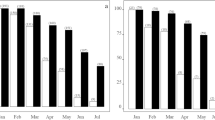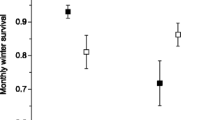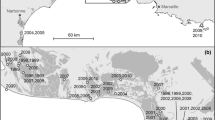Abstract
Dispersal of young from natal home ranges can result in gene flow and increased variation within populations. However, juveniles that remain near kin and form familial groups can accrue indirect fitness benefits. Between 2013 and 2015, we studied families (n = 34) of black-crested titmice (Baeolophus atricristatus) in central Texas to assess factors affecting juvenile dispersal. Our results suggest that males of greater mass relative to siblings tended to be more philopatric than smaller males or females of any size. Dispersal of juveniles was not affected by home range size of the territorial male, habitat composition of the home range (percent woodland cover), or date in which young fledged the nest. Interactions between neighboring groups of related titmice were more tolerant than interactions between unrelated groups. In most cases, retained male juveniles established territories adjacent to their natal home range, likely increasing their fitness by saving energy through tolerant interactions with kin.
Significance statement
Certain species form family groups that provide additional fitness benefits to related individuals. However, not all kin-structured organisms respond to the same factors that enable the persistence of family-dominated populations. We examined factors that could influence the limited dispersal behavior of the black-crested titmouse, Baeolophus atricristatus, in central Texas. Limited dispersal occurs when a juvenile disperses a short distance (< 400 m) and establishes a territory adjacent to its natal home range the following year. In the black-crested titmouse, sex and mass of juveniles greatly influence limiting dispersing individuals, typically with the heaviest male juveniles exhibiting philopatry. Thus, overtime, kin-structured neighborhoods develop, allowing related family groups to spare energetically taxing aggressive behaviors and instead forage passively near one another.


Similar content being viewed by others
Data availability
The datasets analyzed during the current study are available from the corresponding author on reasonable request.
References
Allee WC (1938) The social life of animals. WW Norton, London
Baglione V, Marcos JM, Canestrari D, Griesser M, Andreotti G, Bardini C, Bogliani G (2005) Does year-round territoriality rather than habitat saturation explain delayed natal dispersal and cooperative breeding in the carrion crow? J Anim Ecol 74:842–851
Barnes P, Liang S, Jessup K, Ruiseco L, Phillips P, Reagan S (2000) Soils, topography and vegetation of the freeman ranch. Southwest Texas State University, San Marcos
Bartmess-LeVasseur J, Branch CL, Browning SA, Owens JL, Freeberg TM (2010) Predator stimuli and calling behavior of Carolina chickadees (Poecile carolinensis), tufted titmice (Baeolophus bicolor), and white-breasted nuthatches (Sitta carolinensis). Behav Ecol Sociobiol 64:1187–1198
Bibby CJ, Burgess ND, Hill DA, Mustoe S (2000) Bird census techniques, 2nd edn. Academic Press, New York
Both C, Visser ME, Verboven N (1999) Density-dependent recruitment rates in great tits: the importance of being heavier. Proc R Soc Lond B 266:465–469
Brackbill H (1970) Tufted titmouse breeding behavior. Auk 87:522–536
Brawn JD, Balda RP (1998) Population biology of cavity nesters in northern Arizona: do nest sites limit breeding densities. Condor 90:61–71
Brown JL (1987) Helping and communal breeding in birds: ecology and evolution. Princeton University Press, Princeton
Cale PG (2003) The influence of social behavior, dispersal and landscape fragmentation on population structure in a sedentary bird. Biol Conserv 109:237–248
Caro SM, Griffin AS, Hinde CA, West SA (2016) Unpredictable environments leads to the evolution of parental neglect in birds. Nat Commun 7:10985
Christman BJ (2002) Extreme between-year variation in productivity of a bridled titmouse (Baeolophus wollweberi) population. Auk 119:1149–1154
Clutton-Brock T (2002) Behavioral ecology – breeding together: kin selection and mutualism in cooperative breeders. Science 296:69–72
Cockburn A (2006) Prevalence of different modes of parental care in birds. Proc R Soc Lond B 273:1375–1383
Coulon A, Fitzpatrick JW, Bowman R, Lovette IJ (2010) Effects of habitat fragmentation on effective dispersal of Florida scrub-jays. Conserv Biol 24:1080–1088
Dickinson JL, Hatchwell B (2004) Fitness consequences of helping. In: Koenig WD, Dickinson JL (eds) Ecology and evolution of cooperative breeding in birds. Cambridge University Press, Cambridge, pp 48–66
Dickinson JL, Euaparadorn M, Greenwald K, Mitra C, Shizuka D (2009) Cooperation and competition: nepotistic tolerance and intrasexual aggression in western bluebird winter groups. Anim Behav 77:867–872
Dickinson JL, Ferree ED, Stern CA, Swift R, Zuckerberg B (2014) Delayed dispersal in western bluebirds: teasing apart the importance of resources and parents. Behav Ecol 25:843–851
Dixon KL (1955) An ecological analysis of the inter-breeding of crested titmice in Texas. Univ Calif Publ Zool 54:125–206
Dixon KL (1956) Territoriality and survival in the plain titmouse. Condor 58:169–182
Dixon KL (1965) Dominance-subordination relationships in mountain chickadees. Condor 67:291–299
Dixon KL (1978) A distributional history of the black-crested titmouse. Am Midl Nat 100:29–42
Dunn JL, Alderfer JK (2011) National Geographic field guide to the birds of North America. National Geographic, Washington DC
Ekman J (2006) Family living among birds. J Avian Biol 37:289–298
Ekman J, Rosander B (1992) Survival enhancement through food sharing: a means for parental control of natal dispersal. Theor Popul Biol 42:117–129
Ekman J, Dickinson JL, Hatchwell B (2004) Delayed dispersal. In: Koenig WD, Dickinson JL (eds) Ecology and evolution of cooperative breeding in birds. Cambridge University Press, Cambridge, pp 35–47
Emlen ST (1982) The evolution of helping. I. An ecological constraints model. Am Nat 119:29–39
Environmental Systems Research Institute (ESRI) (2012) ArcGIS Release 10.1. Redlands, CA
Fisher RA (1934) Statistical methods for research workers, 5th edn. Oliver & Boyd, Edinburgh
Fitzpatrick J, Woolfenden G (1984) The helpful shall inherit the scrub. Nat Hist 93:55–63
Green DJ, Cockburn A (2001) Post-fledging care, philopatry and recruitment in brown thornbills. J Anim Ecol 70:505–514
Greenwood PJ, Harvey PH, Perrins CM (1979) The role of dispersal in the great tit (Parus major): the causes, consequences and heritability of natal dispersal. J Anim Ecol 48:123–142
Griesser M, Nystrand M, Ekman J (2006) Reduced mortality selects for family cohesion in a social species. Proc R Soc Lond B 273:1881–1886
Gullett PR, Hatchwell BJ, Robinson RA, Evans KL (2015) Breeding season weather determines long-tailed tit reproductive success through impacts on recruitment. J Avian Biol 46:1–11
Hatchwell BJ (2009) The evolution of cooperative breeding in birds: kinship, dispersal and life history. Philos Trans R Soc B 364:3217–3227
Hatchwell BJ, Sharp SP (2006) Kin selection, constraints, and the evolution of cooperative breeding in long-tailed tits. Adv Study Behav 36:355–395
Koenig WD, Haydock J (2004) Incest and incest avoidance. In: Ecology and evolution of cooperative breeding birds. Cambridge University Press, Cambridge, pp 142–156
Kokko H, Ekman J (2002) Delayed dispersal as a route to breeding: territorial inheritance, safe havens, and ecological constraints. Am Nat 160:468–484
Kokko H, Lundberg P (2001) Dispersal, migration, and offspring retention in saturated habitats. Am Nat 157:188–202
Komdeur J (1992) Importance of habitat saturation and territory quality for the evolution of cooperative breeding in the Seychelles warbler. Nature 358:493–495
Kraaijeveld K, Dickinson JL (2001) Family-based winter territoriality in western bluebirds, Sialia mexicana: the structure and dynamics of winter groups. Anim Behav 61:109–117
Lack DL (1968) Ecological adaptations for breeding in birds. Methuen, London
Lange H, Leimar O (2003) The function of threat displays in wintering great tits. Anim Behav 65:573–584
Layton-Matthews K, Ozgul A, Griesser M (2018) The interacting effects of forestry and climate change on the demography of a group-living bird population. Oecologia 186:907–918
Lemel J (1989) Habitat distribution in the great tit Parus major in relation to reproductive success dominance, and biometry. Ornis Scand 20:226–233
Lendvai AZ, Liker A, Barta Z (2006) The effects of energy reserves and dominance on the use of social-foraging strategies in the house sparrow. Amin Behav 72:747–752
Lima SL (1995) Back to the basics of antipredatory vigilance – the group-size effect. Anim Behav 49:11–20
Lubjuhn T, Gerken T, Brün J, Epplen JT (1999) High frequency of extra-pair paternity in the coal tit. J Avian Biol 30:229–233
Marzluff JM, Heinrich B, Marzluff CS (1996) Raven roosts are mobile information centres. Anim Behav 51:89–103
Monrose JS, Belda EJ, Barba E (2002) Post-fledging survival of individual great tits: the effect of hatching date and fledging mass. Oikos 99:481–488
Moreno J, Gonzalez-Braojos S, Ruiz-De-Castaneda R (2015) A spring cold snap is followed by an extreme reproductive failure event in a mountain population of pied flycatchers Ficedula hypoleuca. Bird Study 62:466–473
Mumme RL, Bowman R, Pruett MS, Fitzpatrick JW (2015) Natal territory size, group size, and body mass affect lifetime fitness in the cooperatively breeding Florida scrub-jay. Auk 132:634–646
Murgui E, Hedblom E (2017) Ecology and conservation of birds in urban environments. Springer International Publishing, New York
Naef-Daenzer B, Grüebler MU (2008) Post-fledging range use of great tit Parus major families in relation to chick body condition. Ardea 96:181–190
Naef-Daenzer B, Widmer F, Nuber M (2001) Differential post-fledging survival of great and coal tits in relation to their condition and fledging date. J Anim Ecol 70:730–738
Neuenschwander S, Brinkhof MWG, Kolliker M, Richner H (2003) Brood size, sibling competition, and the cost of begging in great tits (Parus major). Behav Ecol 14:457–462
Nilsson JA (1989) Causes and consequences of natal dispersal in the marsh tit, Parus palustris. J Anim Ecol 58:383–401
Nocedal J, Ficken MS (1998) Helpers in the bridled titmouse. Southwest Nat 43:279–282
Nystrand M (2007) Associating with kin affects the trade-off between energy intake and exposure to predators in a social bird species. Anim Behav 74:497–506
Oberg M, Arlt D, Part T, Laugen AT, Eggers S, Low M (2015) Rainfall during parental care reduces reproductive survival components of fitness in a passerine bird. Ecol Evol 5:345–356
Orell M, Rytkonen S, Launonen V, Welling P, Koivula K, Kumpulainen K, Bachmann L (1997) Low frequency extra-pair paternity in the willow tit Parus montanus as revealed by DNA fingerprinting. Ibis 129:562–566
Patten MA, Smith-Patten BD (2008) Black-crested titmouse (Baeolophus atricristatus). In: Poole AF (ed) The birds of North America online. Cornell Lab of Ornithology, Ithaca http://bna.birds.cornell.edu/bna/sprcies/717
Pearce-Higgins JW, Green RE (2014) Birds and climate change: impacts and conservation responses. Cambridge University Press, Cambridge
Perrins CM, McCleery RH (2001) The effect of fledging mass on the lives of great tits Parus major. Ardea 89:135–142
Pravosudova EV, Grubb TC, Parker PG, Doherty PF (1999) Patch size and composition of social groups in wintering tufted titmice. Auk 116:1152–1155
Pravosudova EV, Parker PG, Gaunt AS (2002) Genetic evidence for extrapair paternity in the tufted titmouse. Wilson Bull 114:279–281
Pruett-Jones S, Lewis M (1990) Sex ratio and habitat limitation promote delayed dispersal in superb fairy-wrens. Nature 348:541–542
Pulliam HR (1973) Advantages of flocking. J Theor Biol 38:419–422
R Development Core Team (2018) R: a language and environment for statistical computing. R Foundation for Statistical Computing, Vienna http://www.R-project.org
Roberts G (1996) Why individual vigilance declines as group size increases. Anim Behav 51:1077–1086
Sharp SP, Baker MB, Hadfield JD, Simeoni M, Hatchwell BJ (2008) Natal dispersal and recruitment in a cooperatively breeding bird. Oikos 117:1371–1379
Sharp SP, Simeoni M, McGowan A, Nam K, Hatchwell BJ (2011) Patterns of recruitment, relatedness and cooperative breeding in two populations of long-tailed tits. Anim Behav 81:843–849
Sherman PW (1977) Nepotism and the evolution of alarm calls. Science 197:1246–1253
Strickland D (1991) Juvenile dispersal in gray jays: dominant brood member expels siblings from natal territory. Can J Zool 69:2935–2945
Texas Parks and Wildlife Department (2013) GIS maps and spatial strata - Edwards Plateau ecoregion. Texas Parks and Wildlife Department, Austin http://tpwd.texas.gov/gis/
Tinbergen J, Boerlijst M (1990) Nestling weight and survival in individual great tits (Parus major). J Anim Ecol 59:1113–1127
Turpie JK (1995) Non-breeding territoriality – causes and consequences of seasonal and individual variation in grey plovers Pluvialis squatarola behavior. J Anim Ecol 64:429–438
Verboven N, Visser ME (1998) Seasonal variation in local recruitment of great tits: the importance of being early. Oikos 81:511–524
Zach R (1982) Hatching asynchrony, egg size, growth, and fledging in tree swallows. Auk 99:695–700
Zuur AF, Ieno EN, Walker NJ, Saveliev AA, Smith GM (2009) Mixed effects models and extensions in ecology with R. Springer Publishing, New York
Acknowledgments
We thank the Freeman Center staff (Chris Thomas and Stacey Allbritton) for providing service and logistics for this 3-year project, and to Sarah Harrod and the Texas Bluebird Society for providing the nestboxes and laying down the groundwork. We also thank graduate students Anna Matthews, Sarah Durham, and Amanda Haverland for their labor of love volunteering in the field, and to Christina Farrell for assisting with the banding of hundreds of baby titmice. We thank Dr. Butch Weckerly, Dr. Adam Duarte, and Dr. Daniel Wolcott for their statistical advice, and Dr. Stephen Pruett-Jones, along with numerous other anonymous reviewers, for their patience and insightful edits of the manuscript.
Funding
We received funding for this project through the Texas State University Freeman Fellowship Award, Texas State University Durrenberger Scholarship for Women in Science, Texas State University Graduate College Scholarship, and the Texas State University Thesis Research Support Fellowship.
Author information
Authors and Affiliations
Corresponding author
Ethics declarations
Conflict of interest
The authors declare that they have no conflict of interest.
Ethical approval
To carry out this study in accordance with both federal and local laws, we obtained the following wildlife handling permits before research began: Institutional Animal Care and Use Committee (IACUC) (no. 201532811), federal Master Banding Permit (no. 23546), U.S. Fish and Wildlife Permit (MB121162-2), and Texas Parks and Wildlife Collection Permit (no. SPR-0106-005). We handled all birds professionally and ethically as advised by the Ornithological Council’s Guidelines for wild avifauna in research.
Additional information
Communicated by S. Pruett-Jones
Publisher’s note
Springer Nature remains neutral with regard to jurisdictional claims in published maps and institutional affiliations.
Electronic supplementary material
ESM 1
(DOCX 2877 kb).
Rights and permissions
About this article
Cite this article
Rylander, R.J., Fritts, S.R. & Aspbury, A.S. Limited dispersal by large juvenile males leads to kin-structured neighborhoods in the black-crested titmouse (Baeolophus atricristatus). Behav Ecol Sociobiol 74, 65 (2020). https://doi.org/10.1007/s00265-020-02844-x
Received:
Revised:
Accepted:
Published:
DOI: https://doi.org/10.1007/s00265-020-02844-x




